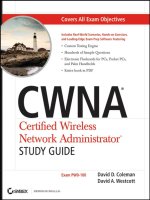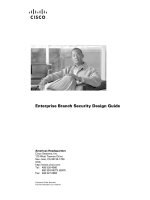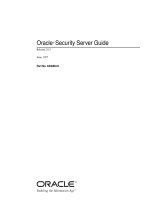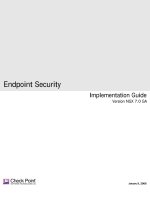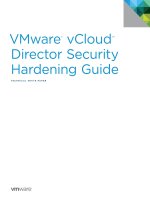CompTIA security+ review guide exam SY0–601
Bạn đang xem bản rút gọn của tài liệu. Xem và tải ngay bản đầy đủ của tài liệu tại đây (13.98 MB, 579 trang )
CompTIA®
Security+® Review Guide
Exam SY0-601
Fifth Edition
CompTIA®
Security+® Review Guide
Exam SY0-601
Fifth Edition
James Michael Stewart
Copyright © 2021 by John Wiley & Sons, Inc., Indianapolis, Indiana
Published simultaneously in Canada
ISBN: 978-1-119-73538-0
ISBN: 978-1-119-73542-7 (ebk)
ISBN: 978-1-119-73536-6 (ebk)
No part of this publication may be reproduced, stored in a retrieval system or transmitted in any form or by any
means, electronic, mechanical, photocopying, recording, scanning or otherwise, except as permitted under Sections
107 or 108 of the 1976 United States Copyright Act, without either the prior written permission of the Publisher, or
authorization through payment of the appropriate per-copy fee to the Copyright Clearance Center, 222 Rosewood
Drive, Danvers, MA 01923, (978) 750-8400, fax (978) 646-8600. Requests to the Publisher for permission should
be addressed to the Permissions Department, John Wiley & Sons, Inc., 111 River Street, Hoboken, NJ 07030, (201)
748-6011, fax (201) 748-6008, or online at www.wiley.com/go/permissions.
Limit of Liability/Disclaimer of Warranty: The publisher and the author make no representations or warranties
with respect to the accuracy or completeness of the contents of this work and specifically disclaim all warranties,
including without limitation warranties of fitness for a particular purpose. No warranty may be created or extended
by sales or promotional materials. The advice and strategies contained herein may not be suitable for every situation.
This work is sold with the understanding that the publisher is not engaged in rendering legal, accounting, or other
professional services. If professional assistance is required, the services of a competent professional person should
be sought. Neither the publisher nor the author shall be liable for damages arising herefrom. The fact that an
organization or Web site is referred to in this work as a citation and/or a potential source of further information
does not mean that the author or the publisher endorses the information the organization or Web site may provide
or recommendations it may make. Further, readers should be aware that Internet Web sites listed in this work may
have changed or disappeared between when this work was written and when it is read.
For general information on our other products and services or to obtain technical support, please contact our
Customer Care Department within the U.S. at (877) 762-2974, outside the U.S. at (317) 572-3993 or fax (317)
572-4002.
Wiley publishes in a variety of print and electronic formats and by print-on-demand. Some material included with
standard print versions of this book may not be included in e-books or in print-on-demand. If this book refers to
media such as a CD or DVD that is not included in the version you purchased, you may download this material at
booksupport.wiley.com. For more information about Wiley products, visit www.wiley.com.
Library of Congress Control Number: 2020950195
TRADEMARKS: Wiley, the Wiley logo, and the Sybex logo are trademarks or registered trademarks of John Wiley
& Sons, Inc. and/or its affiliates, in the United States and other countries, and may not be used without written
permission. CompTIA and Security+ are registered trademarks of CompTIA Properties, LLC. All other trademarks
are the property of their respective owners. John Wiley & Sons, Inc. is not associated with any product or vendor
mentioned in this book.
To Catharine Renee Stewart:
You are my all and my everything, I love you.
Acknowledgments
Thanks to all those at Sybex/Wiley who continue to allow me to do what I enjoy
most—impart knowledge to others. Thanks to Kenyon Brown, acquisitions editor, and the
whole Sybex crew for professional juggling services supremely rendered. Thanks to my
project editor, Kelly Talbot, my technical editor, Buzz Murphy, and my managing editor,
Christine O’Connor. To my wonder woman of a wife, Cathy, and my amazing kids, Slayde
and Remi—you make life exciting and sweet! To my mom, Johnnie: thanks for your love and
consistent support. To Mark: go away or I shall taunt you a second time! Finally, as always,
to Elvis: is the plural of Elvis . . . Elvises or Elvi?
—James Michael Stewart
About the Author
James Michael Stewart has been working with computers and technology since 1983
(although officially as a career since 1994). His work focuses on Internet technologies,
professional certifications, and IT security. For over 20 years, Michael has been teaching
job skill and certification focused courses, such as CISSP, CEH, CHFI, and Security+.
Michael has contributed to many Security+ focused materials, including exam preparation guides, practice exams, DVD video instruction, and courseware. In addition, Michael
has co-authored numerous books on other security and IT certification and administration
topics, including being an author on the CISSP Study Guide 9th Edition. He has developed
certification courseware and training materials and presented these materials in the classroom. He holds numerous certifications, including CEH, CHFI, ECSA, ECIH, CND, CySA+,
PenTest+, CASP+, Security+, Network+, A+, CISSP, CISM, and CFR.
Michael graduated in 1992 from the University of Texas at Austin with a bachelor’s
degree in philosophy. Despite his degree, his computer knowledge is self-acquired, based on
seat-of-the-pants, hands-on, “street smarts” experience. You can reach Michael by email at
About the Technical Editor
George (Buzz) Murphy, CISSP, CCSP, SSCP, CASP, is a public speaker, corporate trainer,
author, and cybersecurity evangelist. A former Dell technology training executive and U.S.
Army IT networking security instructor, he has addressed audiences at national conferences,
international corporations and major universities. He has trained network and cybersecurity operators for the U.S. military branches, U.S. government security agencies, the Federal
Reserve Bank, Sandia National Laboratory, Jet Propulsion Laboratory, Oak Ridge National
Laboratory, and NASA.
As a military datacenter manager in Europe, Buzz has held top-secret security clearances
in both US and NATO intelligence and through the years has earned more than 30 IT and
cybersecurity certifications from CompTIA, (ISC)2, PMI, Microsoft, and other industry
certification organizations.
Buzz has authored or been the technical editor on numerous books on a wide range of
topics including network engineering, industrial control technology, IT security, and more,
including various editions of CASP: CompTIA Advanced Security Practitioner Study Guide,
CompTIA Security+ Study Guide, SSCP: Systems Security Practitioner Study Guide, and
CCFP: Certified Cyber Forensics Professional Certification Guide.
Contents at a Glance
Introductionxix
Chapter 1Threats, Attacks, and Vulnerabilities
1
Chapter 2
Architecture and Design123
Chapter 3
Implementation245
Chapter 4
Operations and Incident Response375
Chapter 5
Governance, Risk, and Compliance441
Appendix
Answers to Review Questions
499
Index519
Contents
Introductionxix
Chapter
1
Threats, Attacks, and Vulnerabilities
1
1.1 Compare and contrast different types of social
engineering techniques.
5
1.2 Given a scenario, analyze potential indicators to
determine the type of attack.
20
1.3 Given a scenario, analyze potential indicators
associated with application attacks.
37
1.4 Given a scenario, analyze potential indicators associated
with network attacks.
57
1.5 Explain different threat actors, vectors, and intelligence
sources.80
1.6 Explain the security concerns associated with various types
of vulnerabilities.91
1.7 Summarize the techniques used in security assessments.
99
1.8 Explain the techniques used in penetration testing.
109
Review Questions
118
Chapter
2
Architecture and Design
2.1 Explain the importance of security concepts in an
enterprise environment.
2.2 Summarize virtualization and
cloud computing concepts.
2.3 Summarize secure application development,
deployment, and automation concepts.
2.4 Summarize authentication and authorization
design concepts.
2.5 Given a scenario, implement cybersecurity resilience.
2.6 Explain the security implications of embedded and
specialized systems.
2.7 Explain the importance of physical security controls.
2.8 Summarize the basics of cryptographic concepts.
Review Questions
Chapter
3Implementation
3.1 Given a scenario, implement secure protocols.
3.2 Given a scenario, implement host or application
security solutions.
3.3 Given a scenario, implement secure network designs.
123
128
139
152
167
183
196
208
220
240
245
248
262
280
xviii
Contents
3.4 Given a scenario, install and configure wireless
security settings.
304
3.5 Given a scenario, implement secure mobile solutions.
315
3.6 Given a scenario, apply cybersecurity solutions to
the cloud.330
3.7 Given a scenario, implement identity and account
management controls.
336
3.8 Given a scenario, implement authentication and
authorization solutions.
344
3.9 Given a scenario, implement public key infrastructure.
355
Review Questions
370
Chapter
4
Operations and Incident Response
4.1 Given a scenario, use the appropriate tool to assess
organizational security.
4.2 Summarize the importance of policies, processes,
and procedures for incident response.
4.3 Given an incident, utilize appropriate data sources
to support an investigation.
4.4 Given an incident, apply mitigation techniques
or controls to secure an environment.
4.5 Explain the key aspects of digital forensics.
Review Questions
Chapter
5
Governance, Risk, and Compliance
375
377
398
409
418
422
435
441
5.1 Compare and contrast various types of controls.
443
5.2 Explain the importance of applicable regulations, standards,
or frameworks that impact organizational security posture.
446
5.3 Explain the importance of policies to organizational
security.456
5.4 Summarize risk management processes and concepts.
469
5.5 Explain privacy and sensitive data concepts in relation
to security.486
Review Questions
494
Appendix
Answers to Review Questions
Chapter 1: Threats, Attacks, and Vulnerabilities
Chapter 2: Architecture and Design
Chapter 3: Implementation
Chapter 4: Operations and Incident Response
Chapter 5: Governance, Risk, and Compliance
499
500
505
508
511
514
Index519
Introduction
The Security+ certification program was developed by the Computer Technology Industry
Association (CompTIA) to provide an industry-wide means of certifying the competency of
computer service technicians in the basics of computer security. The Security+ certification
is granted to those who have attained the level of knowledge and security skills that show a
basic competency in the security needs of both personal and corporate computing environments. CompTIA’s exam objectives are periodically updated to keep their exams applicable
to the most recent developments. The most recent update, labeled SY0–601, occurred in
late 2020.
What Is Security+ Certification?
The Security+ certification was created to offer an introductory step into the complex world
of IT security. You need to pass only a single exam to become Security+ certified. However, obtaining this certification doesn’t mean you can provide realistic security services to a
company. In fact, this is just the first step toward developing and demonstrating real-world
security knowledge and experience. By obtaining Security+ certification, you should be able
to acquire more security experience in order to pursue more complex and in-depth security
knowledge and certification.
If you have further questions about the scope of the exams or related CompTIA programs, as well as to confirm the latest pricing for the exam, refer to the CompTIA website at
www.comptia.org. For details on the exam registration procedures, please visit www.vue.com.
Is This Book for You?
CompTIA Security+® Review Guide: Exam SY0-601 is designed to be a succinct, portable
exam reference book and review guide. It can be used in conjunction with a more typical
study guide, such as Wiley’s CompTIA Security+ Study Guide: SY0-601, with a practice
questions resource, such as Wiley’s CompTIA Security+ Practice Tests: Exam SY0-601, with
computer-based training (CBT) courseware and a classroom/lab environment, or as an exam
review for those who don’t feel the need for more extensive (and/or expensive) test preparation. It is my goal to identify those topics on which you can expect to be tested and to provide sufficient coverage of these topics.
Perhaps you’ve been working with information technologies for years. The thought of
paying lots of money for a specialized IT exam-preparation course probably doesn’t sound
appealing. What can they teach you that you don’t already know, right? Be careful, though—
many experienced network administrators have walked confidently into the test center
only to walk sheepishly out of it after failing an IT exam. After you’ve finished reading this
xx
Introduction
book, you should have a clear idea of how your understanding of the technologies involved
matches up with the expectations of the Security+ test crafters. My goal is to help you understand new technologies that you might not have thoroughly implemented or experienced
yet as well as give you a perspective on solutions that might lie outside of your current
career path.
Or perhaps you’re relatively new to the world of IT, drawn to it by the promise of challenging work and higher salaries. You’ve just waded through an 800-page study guide
or taken a weeklong class at a local training center. Lots of information to keep track of,
isn’t there? Well, by organizing this book according to CompTIA’s exam objectives, and by
breaking up the information into concise, manageable pieces, I have created what I think is
the handiest exam review guide available. Throw it in your backpack or obtain the digital
version and carry it around with you. As you read through this book, you’ll be able to
quickly identify those areas in which you have confident knowledge and those that require a
more in-depth review.
How Is This Book Organized?
This book is organized according to the official objectives list prepared by CompTIA for the
Security+ exam. The chapters correspond to the five major domains of objective and topic
groupings. The exam is weighted across these five topical areas or domains as follows:
■
1.0 Threats, Attacks, and Vulnerabilities (24%)
■
2.0 Architecture and Design (21%)
■
3.0 Implementation (25%)
■
4.0 Operations and Incident Response (16%)
■
5.0 Governance, Risk, and Compliance (14%)
The previous SY0-501 version of Security+ was organized around six domains.
Within each chapter, all of the exam objectives from each domain are addressed in turn
and in order according to the official exam objectives directly from CompTIA. In addition to
a discussion of each objective, every chapter includes two additional specific features: Exam
Essentials and Review Questions.
Exam Essentials At the end of each subdomain objective section, you’re given a list
of topics that you should explore fully before taking the test. Included in the “Exam
Essentials” sections are notations of the key information you should have absorbed from
that section. These items represent the minimal knowledge you should retain from each
chapter section.
Introduction
xxi
Review Questions This feature ends every chapter and provides 20 questions to help
you gauge your mastery of the chapter. For each question you get wrong, take the time
to research why the right answer is correct and why your wrong answer was incorrect.
This helps you learn what you don’t know so you can more effectively handle similar
questions in the future.
This book was not designed to be read cover to cover, but you are welcome to do so.
The organization is based directly on that provided by CompTIA in its official Certification
Exam Objective’s list. This organization is not necessarily always ideal for the order of topics
or the grouping of topics. However, this organization was chosen to make it as easy as possible to locate material related to specific objective items. If you need to read about a specific
topic and know where it is on the objective list, then you can quickly locate it in the pages of
this book. First locate the chapter, then the relevant top-level heading, and then the specific
heading whether it is one, two, or three heading levels below that.
If a topic is included more than once in the objectives, it is usually covered once (and usually at its first occurrence), and then this location is referenced under the other heading locations where it appears again.
As you go over the material in the book, you are also going to discover that CompTIA
did not include all relevant concepts or keywords for a particular topic. When needed,
we added or expanded coverage within the objective headings to include foundational,
background, or relevant material. There are even a few occurrences where a topic was
divided into multiple objectives and then those objects spread across multiple sections.
These are treated like repeats, where full coverage is included in the first instance of the first
topic and references back to this coverage are placed under the other related headings. For
example, “card cloning” and “skimming” are the same thing, so it is covered under “card
cloning,” and a reference to that coverage is listed under “skimming.”
Interactive Online Learning
Environment and Test Bank
We’ve included several additional test-preparation features on the interactive online learning
environment. These tools will help you retain vital exam content as well as prepare you to sit
for the actual exams.
Go to www.wiley.com/go/sybextestprep to register and gain access to
this interactive online learning environment and test bank with study tools.
xxii
Introduction
Sample Tests In this section, you’ll find the chapter tests, which present all the review
questions from the end of each chapter, as well as two more unique practice tests of 90
questions each. Use these questions to test your knowledge of the study guide material.
Electronic Flashcards Questions are provided in digital flashcard format (a question
followed by a single correct answer). You can use the flashcards to reinforce your
learning and provide last-minute test prep before the exam.
Glossary of Terms in PDF We have included a very useful glossary of terms in PDF
format so you can easily read it on any computer. If you have to travel and brush up on
any key terms, you can do so with this useful resource.
Tips for Taking the Security+ Exam
Most CompTIA exams can be taken in-person at a Pearson Vue testing facility or via an
online exam portal. You can elect which test delivery method you want to use when you register for your exam at vue.com.
Here are some general tips for taking your exam successfully:
■
Bring two forms of ID with you. One must be a photo ID, such as a driver’s license. The
other can be a major credit card or a passport. Both forms must include a signature.
■
Arrive early at the exam center so you can relax and review your study materials.
Be connected early if you are taking an online exam. Being 15 minutes early is usually plenty.
■
Read the questions carefully. Don’t be tempted to jump to an early conclusion. Make
sure you know exactly what the question is asking.
■
Read each question twice, read the answer options, and then read the question again
before selecting an answer.
■
You can move forward and backward through the exam, but only one question at a
time. Only after reaching the Review Page after the last question can you jump around
among the questions at random.
■
Don’t leave any unanswered questions. Unanswered questions give you no opportunity
for guessing correctly and scoring more points.
■
Watch your clock. If you have not seen your last question when you have five minutes
left, guess at the remaining questions.
■
There will be questions with multiple correct responses. When there is more than one
correct answer, a message on the screen will prompt you to either “Choose two” or
“Choose all that apply.” Be sure to read the messages displayed so you know how many
correct answers you must choose.
Introduction
xxiii
■
Questions needing only a single correct answer will use radio buttons to select an
answer, whereas those needing two or more answers will use check boxes.
■
When answering multiple-choice questions you’re not sure about, use a process of elimination to get rid of the obviously incorrect answers first. Doing so will improve your
odds if you need to make an educated guess.
■
Try to expand your perspective from your own direct experience. Often the writers of
the exam questions are from large enterprises; if you only consider answers in light of
a small company, military branch, or as an individual, you might not determine the
correct answer.
■
You can mark or flag a question to indicate you want to review it again before ending
the exam. Flagged questions will be highlighted on the Review page. However, you must
complete your review before your exam time expires.
■
Many exam questions will combine concepts and terms from multiple topics/domains
to make the question more challenging. Attempt to figure out the core concept being
focused on. Often, the answer options will provide guidance as to the focus of the
question, especially if the question text itself is not direct and obvious enough.
■
For the latest pricing on the exams and updates to the registration procedures, visit
CompTIA’s website at www.comptia.org.
Performance-Based Questions
CompTIA has begun to include performance-based (scenario-based) questions on its exams.
These differ from the traditional multiple-choice questions in that the candidate is expected
to perform a task or series of tasks. Tasks could include filling in a blank, answering questions based on a video or an image, reorganizing a set into an order, placing labels on a
diagram, filling in fields based on a given situation or set of conditions, or setting the configuration on a network security management device. Don’t be surprised if you are presented
with a scenario and asked to complete a task. The performance-based questions are designed
to be more challenging than standard multiple-choice questions and thus are also worth
more points. Take the time to answer these carefully. For an official description of performance-based questions from CompTIA, visit
www.comptia.org/blog/what-is-a-performance-based-question-
(Note: the final dash is needed; you can also search to find this page with the phrase “What
Is A Performance-Based Question?”) and
www.comptia.org/testing/testing-options/about-comptia-performanceexams/performance-based-questions-explained (this second link is from the Comp-
TIA Security+ information page, so you can follow it from there instead of typing it in).
Exam Specifics
The Security+ SY0-601 exam consists of up to 90 questions with a time allotment of 90
minutes for the exam itself. Additional time is provided for the pre-exam elements, such as
the NDA, copyright disclosures, and the post-exam survey. If you were to be assigned only

